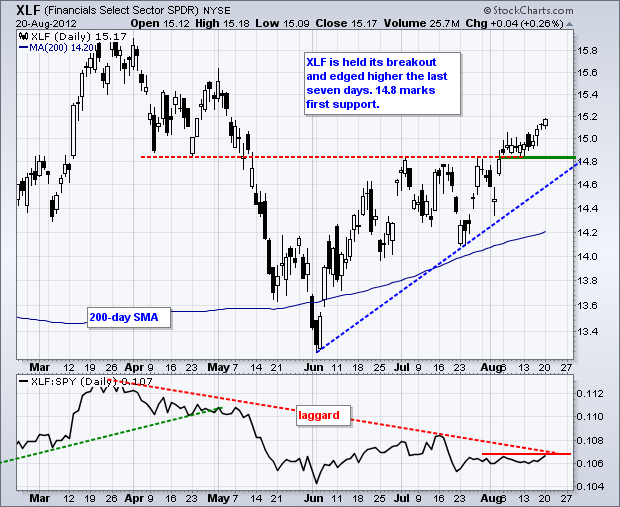Stocks came under selling pressure from profit taking and renewed concerns in the Eurozone. Given the advance of the last few weeks, a little consolidation or even a correction would be normal. The major index ETFs finished slightly lower. Seven of the nine sectors were slightly lower. The Healthcare SPDR (XLV) and the Finance SPDR (XLF) bucked the declines with small gains. Housing stocks were pummeled, but this group is still the strongest overall and remains in a medium-term uptrend. The faa came to life with a surge off support.
On the 60-minute chart, the S&P 500 ETF (SPY) continues to hold its gains and work higher. There was the initial surge above 139 after the employment report and the ETF has slowly worked its gain above 142 the last two weeks. This reflects continued buying pressure. Forget about the low volume. It is the balance of volume that matters. Stocks will move higher when buying pressure (up volume) is stronger than selling pressure (down volume). The consolidation zone marks first support in the 140-141 area.



**************************************************************************
The 20+ Year T-Bond ETF (TLT) is as oversold as stocks are overbought. While the odds of an oversold bounce are high, such a bounce is not guaranteed. Securities can become oversold and remain oversold should buying pressure fail to materialize. A small consolidation formed the last two days and a break above yesterday's high would target a bounce to the 124 area. Such a breakout would be negative for stocks.

**************************************************************************
No change. It could be a big week for the Euro and the Dollar as EU leaders start talking again. French President Francois Hollande and German Chancellor Angela Merkel are scheduled to meet in Berlin on Thursday. This meeting will be followed by individual meetings with Greek Prime Minister Antonis Samaras on Friday and Saturday. There is also talk that the ECB will attempt to cap bond yields. On the chart, the US Dollar Fund (UUP) had a falling wedge working, but triangle consolidation has supplanted this pattern. Last week's range marks resistance and support. Watch these levels for the next directional clue.

**************************************************************************
No change. Oil is moving higher along with the stock market. Tensions in the Middle East could also be fueling the rise in oil. On the price chart, the US Oil Fund (USO) broke flag resistance early last week and continued higher throughout the week. The flag low turns into the first support zone to watch around 34.50. RSI support remains in the 50-60 zone.

**************************************************************************
No change. A big week for Euro/Dollar could mean a big week for gold. Strength in the Dollar would be negative for bullion, while weakness would be positive. There is not much change on the price chart. The Gold SPDR (GLD) is near resistance from the highs extending back to early June. A break above 158 would be bullish, both medium-term and short-term. There is a slight short-term uptrend with the rising lows since mid July, but resistance is proving stiff. First support is set with the July trend line and last week's low (154.8). Key support remains at 153.50

**************************************************************************
Key Reports and Events:
Tue - Aug 21 - 14:00 - FOMC Minutes
Wed - Aug 22 - 07:00 - MBA Mortgage Index
Wed - Aug 22 - 10:00 - Existing Home Sales
Wed - Aug 22 - 10:30 - Crude Inventories
Thu - Aug 23 - 08:30 – Hollande & Merkel Meet in Berlin
Thu - Aug 23 - 08:30 - Initial Claims
Thu - Aug 23 - 10:00 - New Home Sales
Fri - Aug 24 - 08:30 – Samaras & Merkel Meet in Berlin
Fri - Aug 24 - 08:30 - Durable Orders
Sat - Aug 25 - 08:30 – Samaras & Hollande Meet in Paris
Fri – Aug 31 – 09:00 – Jackson Hole Central Bank Symposium
Tue – Sep 11 – 09:00 – Troika to Greece
Charts of Interest: Tuesday and Thursday
This commentary and charts-of-interest are designed to stimulate thinking. This analysis is not a recommendation to buy, sell, hold or sell short any security (stock ETF or otherwise). We all need to think for ourselves when it comes to trading our own accounts. First, it is the only way to really learn. Second, we are the only ones responsible for our decisions. Think of these charts as food for further analysis. Before making a trade, it is important to have a plan. Plan the trade and trade the plan. Among other things, this includes setting a trigger level, a target area and a stop-loss level. It is also important to plan for three possible price movements: advance, decline or sideways. Have a plan for all three scenarios BEFORE making the trade. Consider possible holding times. And finally, look at overall market conditions and sector/industry performance.

About the author:
Arthur Hill, CMT, is the Chief Technical Strategist at TrendInvestorPro.com. Focusing predominantly on US equities and ETFs, his systematic approach of identifying trend, finding signals within the trend, and setting key price levels has made him an esteemed market technician. Arthur has written articles for numerous financial publications including Barrons and Stocks & Commodities Magazine. In addition to his Chartered Market Technician (CMT) designation, he holds an MBA from the Cass Business School at City University in London.
Learn More






